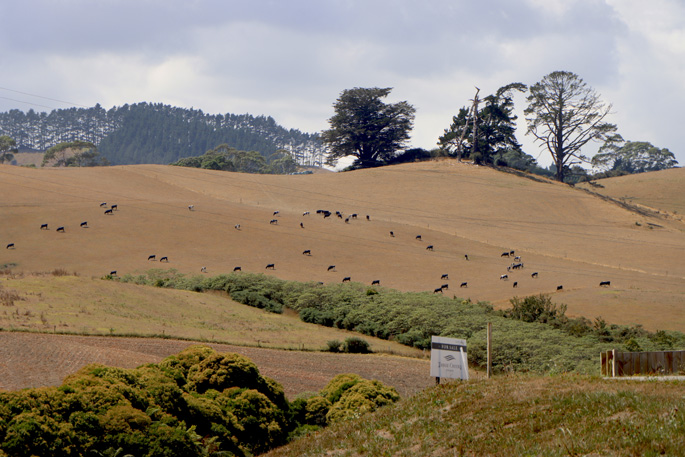Kiwifruit and avocado growers are busy checking irrigation systems are running smoothly to keep fruit growing while dairy farmers are trying to reduce stock numbers and relying on supplementary feed to keep milking in the hope more rain will come soon.
While some regions in the Central Northland received rain late-February, many are still tinder dry after a very mild 12-plus months. And, a fire ban remains in place across the entire North Island.
Federated Farmers Bay of Plenty provincial president Darryl Jensen says the dry is really starting to bite. “Vets say they’re getting inundated with calls from farmers wanting them to scan cows to determine empty stock, so they can de-stock farms to reduce demands for feed,” says Darryl, who farms at Paengaroa.
Darryl says feed supplement – both on-farm and brought-in – is being fed to stock on BOP farms to keep cows milking with pasture extremely dry and grass growth minimal. “Farmers are making calculations on their feed – how much they can feed out now but also how much they need to reserve to get through winter. This call will be coming soon for many farmers.”
Meanwhile, Federated Farmers Waikato provincial president Andrew McGiven’s region is brown with grass growth rates non-existent. “On the plus-side, with the good winter and spring we had in 2019 nearly everyone I’ve spoken to has still got good amounts of supplementary feed – whether it be grass silage etc. But we are all chewing through it at very fast rates.
“And silage supplies online are still at reasonable prices – so feed availability is still there at the moment and maize crops – soon to be harvested – by and large are looking very good too.”
Meatworks delays
The main woe is delays at meatworks preventing farmers from reducing stock numbers. “Whether that’s the China situation or the normal influx of animals coming out of the woodwork in a dry spell…so it’s a matter of planning well-ahead and expecting at least a 10-day to three-week wait for the meatworks.”
And despite low water tables with most Waikato farmers 300m-400mm behind their usual 12-month rainfall, Andrew hasn’t heard of anyone’s water supplies drying up. “This is good news as animal welfare is the priority and that would be a nightmare situation for the farmer involved.”
Hugh Moore, who runs avocado orchard management and harvesting cool storage service KauriPak at Kauri Point near Katikati, says it’s probably one of the severest dry periods the WBOP has seen.
“One of the reasons for that is we’ve actually been in a type of ‘drought’ for 18 months. We haven’t had our aquifiers filled up and if you look at the last 18 months it’s probably been some of the driest months on record.
“This means our drought started quite early – we’ve been irrigating since October. Last year we began mid-December. And our tensiometers through winter showed deficits at deep levels, at 900m,” says the kiwifruit and avocado grower.
“So there is kiwifruit in stress, such as outside rows, avocados are fighting it but fruit will start to slow down. I’m currently measuring kiwifruit growth and growth is slowing.”
Hugh says while kiwifruit will have a higher dry matter content this upcoming season, he expects smaller size fruit. “The 1982 drought I remember – I believe this is worse. This time we’ve virtually had no rain.
“We’ve just had to choke one of our bores back. So we were pumping too fast for what it could give us – and we haven’t had to do that before.”
Water irrigation
Aongatete Avocados Ltd’s Tony Bradley, who grows kiwifruit and offers avocado orchard management services in the Western BOP, says his team is busy ensuring water irrigation systems are running properly to plants. “It’s very dry – for small avocado trees you need to be watering twice-a-week.”
Tony says this period’s normal fruit drop could be much bigger due to being so dry and many avocados on trees are soft to touch and easy to knock off – and the ability to keep fruit for more than three weeks is decreasing.
Tony says kiwifruit crops have just been thinned again to rid of reject and small fruit, and the aim now is to build dry matter. “There might be smaller fruit – but it will be high in taste and it will be a good harvest year – not for volume but for quality.”
Bill Webb of Paengaroa-based Bill Webb Feed Solutions says a Pongakawa dairy farmer told him they’d dropped back to once-a-day because he was running out of feed. “He’s basically giving the cows silage, PK and a picking of grass as he’s not too sure he’ll still be milking at the end of February when we deliver his maize silage. So if we don’t get some decent rain shortly, there will be a lot of farmers drying off early.”
And some maize crops are starting to show signs of moisture stress. “You can see driving around that the lighter areas of the soil and paddocks are definitely starting to dry out.
“They call this pineappling, where it goes spiky and a blue-green colour where all moisture has gone out of the plant. So it’s going to be a bit of a fickle maize harvest season I’d say – unless we get rain.”



0 Comments
Leave a Comment